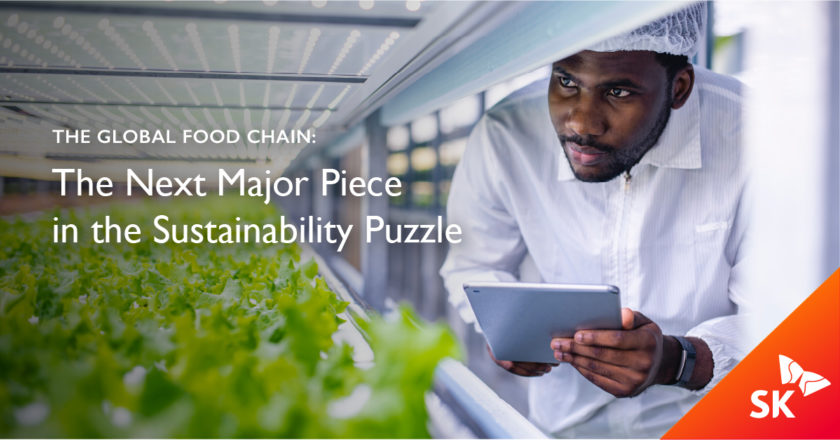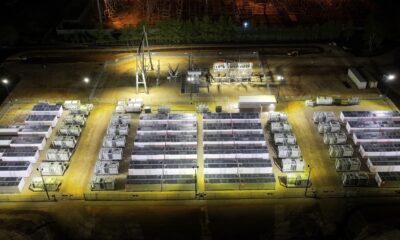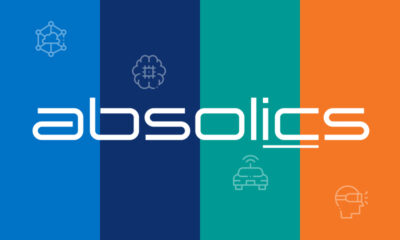The Next Major Piece in the Sustainability Puzzle: The Global Food Chain
By Moohwan Kim, Executive Vice President, Green Investment Center, SK Holdings
January 26, 2021

Until now, sustainability programs have largely focused on two high-profile areas – energy and recycling. But as the importance of sustainability grows and evolves, the emphasis is expanding into virtually every area of work and life.
The food chain is fast-becoming one of the new areas for sustainability activity and innovations. When you take a step back and think about it, the food chain’s critical role in preserving the environment and combating climate change makes sense. From farm to grocer to dinner table and beyond, there are a number of touchpoints in the journey of our food where minor adjustments can make a major difference.
This focus on the food chain is about reducing both food waste and greenhouse gas emissions. In the United States, food waste is estimated at between 30–40 percent of the food supply, creating the single largest category of material placed in municipal landfills. The U.S. Environmental Protection Agency also estimates that agriculture processes contribute about 10 percent of all greenhouse gas emissions in the U.S., driven in large part by methane emissions from livestock.
But what’s the solution? That’s a question trying to be answered by a broad range of players – farmers, food companies, grocers, restauranteurs, researchers and now an emerging set of technology start-ups. Simply put, they are finding that while the answers are varied and complex, there are promising signs that innovative approaches can and will have positive short-term and long-term impacts.
Farming 2.0
Out on the open land, farmers and ranchers across the U.S. have long been at the forefront of climate-smart farming. Over the last five years, they have collectively added 132 percent more renewable energy sources, such as solar panels, windmills, hydro systems and methane digesters, to minimize their environmental impact, according to the American Farm Bureau Federation.
New methods for growing, including vertical farming, also are getting more attention. With a smaller and more flexible farming footprint, vertical farming enables operations to move into urban areas, requiring less time and energy to transport food to the end consumer. The ability to replicate sunlight through the use of LED lighting – powered by those same renewable energy sources – is making this approach to farming even more appealing.
Ranchers, by contrast, are exploring the use of feed additives that can reduce methane emissions from livestock. These sorts of changes could yield positive results for both the animals, as well as the environment. Certain dietary additives for cows not only reduce methane but also create a more efficient, energy rich mix for the livestock.
Introducing Food Alternatives
In addition to new farming techniques, there’s been a recent push into new food alternatives – plant-based food products that traditionally would have been animal-based. Aside from the dietary benefits, plant-based options are getting more attention because they often require less energy, land and water to produce than their animal counterparts while eliminating the methane emissions from livestock.
Perfect Day, an SK Holdings investment, is an example of a company that’s generating interest by developing an animal-free dairy alternative used in everything from cream cheese to ice cream. Impossible Foods, known for its plant-based Impossible Burger, has captured headlines for its resemblance – both in look and taste – to beef burgers.
In a relatively short period of time, these food alternatives have grown in popularity, with the market expected to grow at a CAGR of 11.9 percent to reach $74.2 billion by 2027.
Applying Technology to Food Production
On the technology front, blockchain technology and the Internet of Things are having a transformative impact on the food industry – from agricultural production and the supply chain to the protection of food during distribution into the marketplace.
Blockchain technology, with its ability to secure and authenticate data, is bringing greater end-to-end transparency to the industry and providing more reassurances around metrics for food safety, such as temperature control. The Internet of Things, which brings connectivity to a growing list of devices, can be integrated into sensors that provide real-time alerts to address fluctuating temperatures that could taint a crop.
Meanwhile, predictive analytics through artificial intelligence and machine learning are enabling retailers to more precisely predict demand and adjust orders to reduce in-store waste.
Innovations in food packaging also are creating a more efficient, environmentally friendly food chain. Plastics continue to advance to provide increased shelf life while new specialty films and coatings are emerging to keep food fresh for longer, which helps reduce food waste and production. The after-effects of food packaging also remains an area of innovation. SK Global Chemical and SKC are two SK affiliates exploring new ways to ensure more food packaging can be easily recycled or reused for other purposes.
Expanding the Efforts
The sustainability efforts across the food chain could have a tremendous impact locally and globally. While energy production and transportation are the top sources of greenhouse gas emissions, a recent scientific report concluded that global climate change goals can only be met by also reducing the environmental impact of the food chain.
Companies from a wide range of fields and geographies are answering this call for change. They’re rethinking the way food is produced and distributed with sustainability in mind. The interest and innovations will only increase as more businesses and consumers realize the advantages of creating a food chain that’s both better for our planet and better at meeting the food demands of its population.


